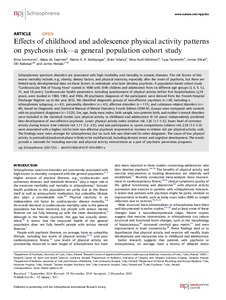Effects of childhood and adolescence physical activity patterns on psychosis risk—a general population cohort study
Elina Sormunen; Maiju M. Saarinen; Raimo K. R. Salokangas; Risto Telama; Nina Hutri-Kähönen; Tuija Tammelin; Jorma Viikari; Olli Raitakari; Jarmo Hietala
https://urn.fi/URN:NBN:fi-fe2021042717414
Tiivistelmä
Schizophrenia spectrum disorders are associated with high morbidity and
mortality in somatic diseases. The risk factors of this excess mortality
include, e.g., obesity, dietary factors, and physical inactivity,
especially after the onset of psychosis, but there are limited early
developmental data on these factors in individuals who later develop
psychosis. A population-based cohort study “Cardiovascular Risk of Young
Finns” started in 1980 with 3596 children and adolescents from six
different age groups (3, 6, 9, 12, 15, and 18 years). Cardiovascular
health parameters, including questionnaire of physical activity before
first hospitalization (≤18 years), were studied in 1980, 1983, and 1986.
All psychiatric diagnoses of the participants were derived from the
Finnish Hospital Discharge Register up to the year 2012. We identified
diagnostic groups of non-affective psychosis (n = 68, including a schizophrenia subgroup, n = 41), personality disorders (n = 43), affective disorders (n = 111), and substance-related disorders (n = 49),
based on Diagnostic and Statistical Manual of Mental Disorders, Fourth
Edition (DSM-IV). Groups were compared with controls with no
psychiatric diagnoses (n = 3325). Sex, age, body mass index,
birth weight, non-preterm birth, and mother’s mental disorders were
included in the statistical model. Low physical activity in childhood
and adolescence (9–18 years) independently predicted later development
of non-affective psychosis. Lower physical activity index (relative risk
1.26 [1.1–1.5]), lower level of common activity during leisure time
(relative risk 1.71 [1.2–2.5]), and non-participation in sports
competitions (relative risk 2.58 [1.3–5.3]) were associated with a
higher risk for later non-affective psychosis (expressed as increase in
relative risk per physical activity unit). The findings were even
stronger for schizophrenia, but no such link was observed for other
diagnoses. The cause of low physical activity in premorbid/prodromal
phase is likely to be multifactorial, including deviant motor and
cognitive development. The results provide a rationale for including
exercise and physical activity interventions as a part of psychosis
prevention programs.
Kokoelmat
- Rinnakkaistallenteet [27094]
